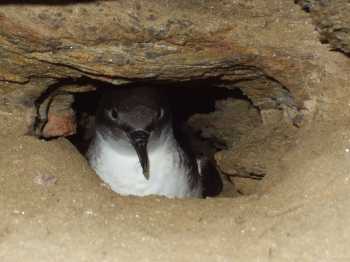Elsa Bonnaud (Unité Ecologie, Systématique et Evolution, Université Paris-Sud, Orsay, France) and colleagues have published in the journal Biological Invasions on feral Domestic Cats Felis catus preying upon Yelkouan Shearwaters Puffinus yelkouan in the French Mediterranean.
The paper’s abstract follows:
“Domestic cats are one of the most widespread predators on islands worldwide and are responsible for numerous reductions and extinctions of species on islands. The three main islands of the Hyères Archipelago house one of the largest colonies of the Mediterranean endemic Yelkouan shearwater Puffinus yelkouan that has recently been up-listed by the IUCN to ‘vulnerable’. The main objectives of this study were to assess the diet of cats and to study the effect of cat predation on Yelkouan shearwater populations at the archipelago scale. The diet of cats was studied using scat analyses according to years and seasons for each island. Simultaneously, Yelkouan shearwater breeding success was monitored during a period of 8 years on Port-Cros and Porquerolles, and 3 years on Le Levant. Descriptive analyses and GLM were used to compare data gathered on each island. At the archipelago scale, cats preyed strongly upon introduced mammals and shearwaters. Surprisingly, large differences appeared in cats’ diet according to the island considered. The Yelkouan shearwater was the primary prey of cats on Le Levant, but secondary on Port-Cros and Porquerolles. Cat predation was mainly concentrated during the shearwater prospecting period, when birds arrive at the colonies and look for a mate (if they are not already paired) and a burrow before breeding. Consequently cat impact was low on shearwater breeding success. However, this study demonstrates that the cat management conducted on Port-Cros was positive for fledging success. The successful cat eradication on Port-Cros supports the need to continue working for Yelkouan shearwater conservation with Le Levant as a priority, because this is where the colonies are largest and predation on Yelkouan shearwaters is very high.”

At risk to cats: a Yelkouan Shearwater in its burrow, photograph by Jerome Lagrand
Reference:
Elsa Bonnaud, E., Palmas, P., Bourgeois, K., Ollier, S. Zarzoso-Lacoste, D. & Vidal, E. 2015. Island specificities matter: cat diet differs significantly between islands of a major breeding archipelago for a vulnerable endemic seabird. Biological Invasions DOI 10.1007/s10530-015-0921-4.
John Cooper, ACAP Information Officer, 13 July 2015

 English
English  Français
Français  Español
Español